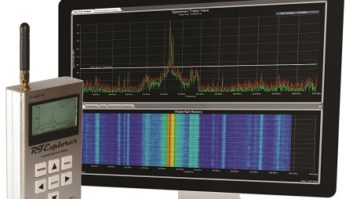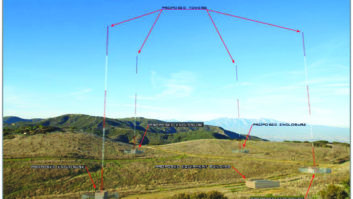
Crawford Broadcasting President Don Crawford looks down on the new site from the knoll where the old Roaney ‘hamshack’ used to sit. With this article, we begin the account — the saga, really — of the relocation of the KBRT(AM) transmitter site from Santa Catalina Island to a new locale on the mainland.
What makes it both a saga and, we hope, of interest to broadcast engineers and professionals are that the process took 5-1/2 years and required the services of environmental, architectural, cultural, political and engineering consultants, in addition to the personal involvement of many within our company.
This was no handoff to an outsourced project manager. It was, instead, a way of life for me and several others in our company.
Today we’ll deal with the challenges and obstacles we faced before the first spade of dirt was turned. We’ll conclude with the actual construction in Part 2, which will be published in August.
THE BEGINNING
Since late 1979, Crawford Broadcasting Company has owned and operated KBRT in Southern California. The station airs on 740 kHz and is licensed to Avalon, the tiny one-square-mile harbor town on Santa Catalina Island, “Twenty-six miles across the sea …”
Since 1952, it has transmitted from a site in the island’s interior. The seawater path to the mainland coast gave KBRT’s 10 kW signal the unique advantage of a very low attenuation path to all of Southern California, from Santa Barbara to San Diego, something no other station could claim.
When the long-term transmitter site lease was negotiated, 2013 must have seemed like forever in the future. In 2005 and 2006, with the expiration date looming, I began trying to negotiate a new lease for the station, but I didn’t get very far.
For a number of reasons, most of which are still unclear to me, our landlord, the conservancy that owns almost all the island, evidently did not feel that our transmitter site and towers were a good fit with its conservation objectives on the island. A wildfire that was started at our site by a tower contractor in May of 2007 did nothing to change the landlord’s mind, so in the fall of 2007, the search for a new site got underway.
CBC President Don Crawford said, “KBRT and Kiertron Inc. have been tenants in good standing on Santa Catalina Island for the past some 33 years. It became obvious the conservancy would not intend to renew our lease for our tower and transmitter site, which would have expired at the end of the year 2013. That created a desperate do or die situation, for it meant that we would need to find another site for our station. Failing that, there would be no KBRT, no alternative, license gone and the station dark forever.”
Ideally, we would be able to locate another island site, but since the conservancy owns almost every square inch of the island, that was not to be. There are a few private parcels outside the town, parcels owned by Southern California Edison and one or two private individuals, but there was none of a size suitable for a directional AM array. That meant we would be searching for a mainland site.
And search we did. For a solid year, I made countless trips to Southern California, looking first at possible collocations, then at landfills and just about every open space from Rialto to Laguna Beach.
We had a glimmer of hope at one point at a “mature” landfill in eastern Orange County. The manager saw that radio towers would be an excellent use for the otherwise empty land, and he liked the possibility for an income stream as well. We found out in short order, however, that the land grant for the landfill specifically excluded communications towers of any sort. Evidently the grantor did not want unsightly towers cluttering the skyline.
NOT IN MY BACKYARD
We eventually reached the conclusion that constructing three or four towers of any height anywhere in Southern California that might work for our allocation and coverage objectives was going to be close to impossible. The entire area is highly developed. Just about all the open space is within sight of homes and businesses, and both NIMBY and BANANA are very well known principles there. [Ed. Note: We had to look that one up: “Build Absolutely Nothing Anywhere Near Anything.”]
We would have to find a place that was not near anything. I was starting to think we might have to consider moving out into the desert east of the area when my friend Ben Dawson suggested I look at a mountaintop site that was once home to the three-tower array for what is now KLAA (830 kHz). It originally operated under call letters KPLS.
With the help of local consulting engineer Larry Morton, I got in touch with the owner of that particular 12-acre parcel and we went up to look at it. The site, located in a basin along the spine of the Santa Ana Mountains in eastern Orange County, was moderately sloped and a 15-minute, five-mile switchback dirt road drive from civilization.
Surrounded on all sides by the Cleveland National Forest, there was no commercial power or other utilities, and there were certain to be other issues as well, but it was indeed a site that was close to absolutely nothing. Sight lines to the developed areas below were few, so we began to think we were onto something.
Ben Dawson recalls: “Cris had looked all over the place for a new site, and when I suggested that he look at the Oak Flat original 830 site, it didn’t seem ideal, but at least worth examining. And it had the advantage of measured conductivity from the 830 antenna proof, so it was just a bit better than a pig in a poke. I wasn’t at all sure about its suitability, but as Cris kept digging into the problem it began to look more like a flower than a farm animal!”
Our first look at the Oak Flat site revealed the heavily vandalized remains of what had been a world-class ham radio station.MORE LAND WITH A STORY

Twelve acres, however, would not be enough.
A preliminary allocation study showed that we would need four towers in a parallelogram array, and for that, we would need 20+ acres. With that in mind, I began looking at adjacent parcels, the 13-acre parcel to the northwest in particular.
That site had been the world-class amateur radio station of Dr. Robert Roaney (K6RR) from 1973–1990. The heavily vandalized remains of the 1,200 square foot “hamshack,” generator fuel tank and 20+ wooden poles that supported Dr. Roaney’s rhombics and vertical yagi stacks were still in place. Dr. Roaney, an avid “DXer,” had what had to be the biggest signal on the west coast from the site. People came from the world over to operate his station, particularly during contests. The website QRZ.com has some history and photos of the site from its heyday.
The parcel was, at the time we looked at it, owned by a conservation organization out of Arizona, evidently their only California property, and they were happy to be rid of it. On Dec. 30, 2008, after as much due diligence as we could squeeze in before a year-end deadline imposed by the Arizona conservancy, we closed on the purchase of both parcels.
KBRT was the proud owner of a 27-acre desert mountaintop site with no power, no phone service and uncertain possibilities for the future.
The site had some things going for it. One was proper zoning. “Telecommunications transmission and relay facilities” was specifically listed as a permitted use in the zoning definition. Another was isolation — it was far from homes, businesses, commuter corridors and sensitive areas.
Finally, it offered the best compromise I could find for meeting the allocation requirements and coverage objectives. Ground conductivity was, based on measurements made when the 830 station was located there, not bad. Good conductivity paths existed into Los Angeles, Orange County and the Inland Empire. If we could find a way to build at the site, we could serve the entire area with a good signal.
A test antenna consisting of a top-loaded 50-foot mast was used to test ground conductivity at the site.POWER!

When KPLS operated from Oak Flat in the late 1980s, it had to generate all its own power on-site. There were no reasonable options for bringing power to the site at the time. That meant hauling a load of diesel to the site every week or so, and that was sometimes impossible when it was raining or after a few days of wet weather. That switchback dirt road was tough enough in wet weather in a 4WD passenger truck or SUV; it was impassible for even a small fuel tanker.
Since then, the federal government had constructed a NOAA Doppler radar site on a hilltop about a mile southwest of the site, and they had trenched in primary power to serve the facility. That meant we might be able to trench from there to our site and get commercial power.
Soon after purchasing the site, we called Southern California Edison and had them send out their service planner for the area. He came armed with a roll of maps and charts showing their grid in the area. Indeed, there was 12 kV three-phase primary power at the radar site, and it did have considerable excess capacity. All we had to do was get an easement over a mile of a neighbor’s land to trench in some conduit. That was much easier said than done for a number of reasons.
Without going into details, we did eventually obtain the needed easement after much legal wrangling with the property owner. It was beneath a county road easement across the neighbor’s land, a serpentine route across the mountaintops. We would have to trench the entire route under that road, installing conduit (Edison calls it “duct”) and concrete pull boxes with heavy-duty traffic-rated lids every 500 feet or so. It wouldn’t be cheap, but it was beginning to look like we just might eventually get power to the site.

We had to drill a lot of test holes to determine the geologic makeup of the new site. Before we could break ground, we needed a county permit to dig up their road and a Forest Service permit to operate our equipment over one of their roads. The county permit took some doing — the traffic engineer who reviewed the application and plans treated the situation as if it were a concrete thoroughfare through the middle of a city and not a dirt two-track in the middle of nowhere that had not seen a county grader blade in years! Eventually, we compromised and got the permit. The Forest Service folks, on the other hand, were very helpful and cooperative. We had no problems getting a road permit from them.
Trenching started in May 2012 and the power meter was set on Oct. 23, 2012.
From site acquisition through easement grant, two permit processes and construction, it took almost four years to get power to the site and it cost a fortune; but we got it done!
FAA AND FCC APPS
Backing up a bit in the chronology:
Before we closed on the two parcels, and with the then-owner’s permission, I filed an FAA Form 7460-1 for each of four 281-foot towers that we would need to operate from the site. This was very much a due diligence item; we would not close on the land if the FAA said no. The good news is that they rather quickly issued a Declaration of No Hazard to Air Navigation.
Shortly after receiving those documents, I filed antenna structure registration applications with the FCC. In those days, grant was virtually automatic, and in short order we had ASRs in hand.
The FCC application would be a considerably more complex undertaking. KBRT originally went on the air as KBIG, 740 kHz, from the island transmitter site in 1952, a time when the FCC was predisposed to waive its own interference protection rules in order to get a new first local service into a particular community. As a result, KBIG on 740 kHz had a lot of contour overlap with co-channel KCBS in San Francisco.
The situation got worse in 1961 when the clear channels were realigned; 540 kHz was given to the Mexicans as a clear channel, forcing KFMB in San Diego to find a new frequency. The story goes that they were offered 760 and 830 kHz, and for reasons on which I can only speculate, they chose 760 kHz. That resulted in a lot of overlap and interference between KFMB and KBIG/KBRT over the years.
So the allocation study would not be a relatively simple matter of finding all the protected contours, determining the maximum permissible radiation from the new site to each point on those contours and then designing a directional antenna to meet all the protections. If we did that, KBRT would be a peanut whistle, unable to serve the market.
The procedure we followed was to use the location of the existing KBRT contours and work backward from there, determining the radiation at each azimuth that would not move those contours closer to the protected stations. That involved a lot of manual calculations. We also had to protect a co-channel station in Phoenix and KSPN in Los Angeles on 710 kHz. To say the least, the allocation picture was complex.
Thanks to the 830 operation from back when, we had good measured conductivity data on a lot of radials, but there was one radial, the one toward KSPN (710), where we did not. To get data in that direction, we got an STA and set up a test antenna, feeding it with 1 kW on 1700 kHz.
We retained Hatfield & Dawson to pick up where I left off preparing the engineering exhibits for the FCC application. I had determined that we could do 50 kW from the new site using a four-tower directional antenna, and we carefully worked together to optimize that pattern to meet the allocation restrictions and maximize coverage into key areas.
Of course I had to go through a NEPA (National Environmental Protection Act) screening study and comply with the NPA (Nationwide Programmatic Agreement, which deals with Native American tribes) before we could file. We retained EBI Consulting to do these screens for us and prepare the required documentation. That took a few months.
The FCC application was filed in Dec. 2010; it was granted in Jan. 2011. At that point, we were able to check the FCC off our list.
USE PERMIT
The local and state regulatory agencies concerned me the most, however. The zoning required us to obtain a county use permit for the site before we could file building permit applications. Not knowing what was required, I prepared a presentation outlining the project and set a meeting between our team (our architect/engineer and myself at that point) and the Orange County planning department.
That June 2010 meeting was a real eye-opener. I found out that there is a 30-foot height limit on towers throughout the county. I was told in no uncertain terms that we would not be able to construct four 281-foot towers on our property regardless of the zoning, FAA/FCC approvals or anything else.
It was a very quiet flight back to Colorado that evening as I pondered where to go from there. The clock was ticking — our Dec. 31, 2013 lease expiration was looming.
It was during a homeowner’s association board meeting back in Colorado a week or two later that it was suggested to me that I talk to our board chairman, Michael Sheldon, about the situation. I had known Michael for years and knew he was a well-connected developer, having obtained the approvals for many projects in Colorado. If you have heard of it in this state, chances are Michael had a hand in getting it approved.
So I called Michael, set up an appointment and went over our project and the response we got at the county. Michael said, “We’ll get this done.” Within a few weeks, he and I were on a plane heading west, on our way to a meeting with two of the county supervisors (one, the chairman emeritus and the supervisor in whose district the site was located, and the other the supervisor for our studio’s district). The head of Orange County planning was also there. We presented our project, talked about the radio station, its impact on the community, the jobs that would be lost if the station went away and the benefits of the station to the local businesses that advertise on the station.
By the end of that meeting, the supervisors had mapped out a way to get the project approved. We had a plan and a goal of a hearing before the planning commission later that year. And we had a lot of work to do.
Read the second and concluding part of this story.
Cris Alexander is the director of engineering at Crawford Broadcasting and a past recipient of SBE’s Broadcast Engineer of the Year award.
A story in Radio World in January told of the history of KBRT’s former site on Catalina Island. Read it atradioworld.com/kbrt.












